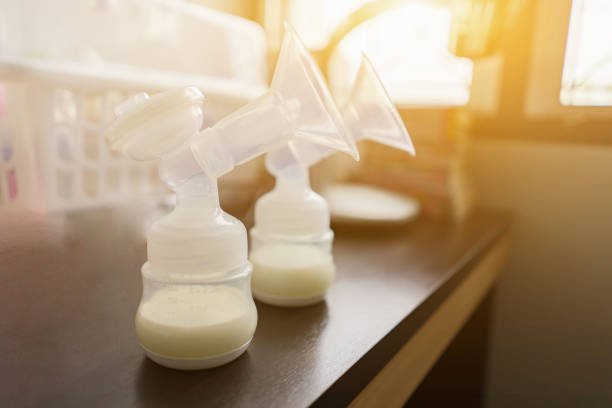Here’s a fun fact: babies usually go through as many diapers as their age in days, showing they’re getting enough to drink. For moms who breastfeed, keeping their milk supply up is very important. But some worry if pumping might lower how much milk they make. This study dives into how pumping affects milk production, especially for moms who had a C-section.
Our research discovered that using a pump that can mimic a baby’s suction strongly can help start milk production and increase milk during the day, specifically for moms who gave birth by C-section. This method seemed to make these moms feel more confident about breastfeeding too. But, using such a pump may also make the nipples hurt and cause tiredness. Even so, these negative effects were not always clear.1 These results hint that using the right pump pressure can help moms who had a C-section breastfeed better.

Key Takeaways
- Pumping at the right pressure can improve milk production and supply, especially for cesarean-delivered mothers.
- It’s essential to use the right pump settings and fit the pump correctly to keep milk flowing well.
- Things like hormones, how the baby feeds, and what the mom eats can help or hurt milk production.
- Power pumping and taking breaks focused on nursing can increase milk supply when needed.
- Getting help from experts and using all the available resources can help new moms to keep up their milk supply.
Introduction to Breast Pumping and Milk Supply
Breastfeeding is the best way to feed a baby, with many good effects for both mom and child. Keeping a good milk supply is key to successful breastfeeding. Some moms worry that pumping might lower their milk supply.2
Importance of Breastfeeding and Maintaining Milk Supply
Starting to lactate late and not making enough milk can happen, especially after a C-section. It’s key for moms to know what influences milk supply and how pumping affects it. This helps in breastfeeding successfully.2
Common Concerns about Pumping and Milk Supply
Some moms worry that using a pump might reduce their milk supply. But, breastfeeding works on a simple rule: the more milk taken out, the more your body makes.2
Factors Affecting Milk Supply
Many things can affect how much milk a mother makes. This includes changes in hormones, how often the baby feeds, and how the baby grows. Also, the mother’s diet and how much water she drinks matter a lot.3
Hormonal Changes and Breastfeeding
After childbirth, a mother’s hormones change a lot. The drop in progesterone after the birth starts the process of making a lot of milk. This process, called lactogenesis stage II, can be influenced by many things. These include how the baby reacts and the mother’s own health.3
Baby’s Feeding Habits and Developmental Changes
How the baby feeds is key. The baby’s sucking power and how often they feed tells the mother’s body how much milk to make. This is called the supply and demand system.3
Maternal Hydration and Nutrition
The mother’s diet and drinking enough water are very important for milk production. Without proper nutrition and hydration, milk supply could suffer.3 Working out can also help a mother feel less stressed after having a baby.4 Breastfeeding uses up a lot of calories, around 500 a day.4
Keeping hydrated is crucial for milk supply, as water affects milk levels directly.3 Eating well is important for keeping up your energy while breastfeeding. This is a helpful tip to ensure milk production stays the same.3

Getting sick with the flu or stomach problems doesn’t usually make milk supply drop. But feeling tired and eating less can affect it. A little bit of coffee or soda is okay for breastfeeding moms. They don’t lower milk supply.4 Drinking a little alcohol won’t harm the baby. Just wait a couple of hours after drinking to nurse again.4
Moms can increase milk by pumping more, making sure the breast is emptied after each feed, and eating oats or taking fenugreek. Pumping often tells the body to make more milk, following a supply-and-demand rule.3
Sometimes moms need to use formula. This might happen if they go back to work. When working, pumping about every three hours helps keep the milk supply steady.4
Will Pumping Reduce Milk Supply?
Understanding the Supply and Demand Nature of Breastfeeding
Many breastfeeding moms worry about pumping and its effects on their milk supply. The main idea of breastfeeding is simple: the more milk you remove, the more your body makes.5 So, whether you’re nursing or using a pump, taking milk from your breasts does two things.
First, it tells your body to keep making milk. Second, it helps avoid any milk getting backed up. If you skip a pump or don’t do it very often, your body might think it doesn’t need to make as much milk.5
Impact of Pumping Frequency and Duration
How often and how long you pump really affects your milk supply.5 It’s vital to know this supply and demand idea to keep milk flowing when you add pumping to breastfeeding.
Pumping consistently helps your body keep up with the “supply and demand” of milk. This means more milk will be there when your baby needs it.3
If you miss nursing sessions because you’re pumping instead, it could lower your milk supply.6 But, too much pumping can also bring its own problems. It might cause your breasts to get too full, leading to pain or even infection.6 Yet, if you’re away from baby for work or school, pumping can help keep your milk supply steady.6
Optimizing Pumping Techniques for Milk Supply
To keep up or boost milk supply by pumping, it’s key to tune your techniques just right.7 Choosing the right size for your breast pump flange is crucial. A wrong size can make milk pumping less effective and even harm your nipples.8 A high-quality pump, especially those used in hospitals, with settings you can adjust, also plays a role in how much milk you produce.
Adjusting Pumping Pressure and Suction Levels
8 Finding the best pressure and suction for you can improve how well your breasts make milk flow. Each person may need different settings. Making changes to your routine to fit your needs can make your pumping times more productive. This way, you can either keep your milk supply up or increase it.
Proper Pump Flange Sizing and Efficient Breast Pumps
8 A top-grade, hospital-style breast pump with adjustable settings can be a game changer for milk production. Don’t forget the importance of right flange fit to prevent problems and get the most milk out.7 Getting these small points right can make sure your pumping boosts or keeps up the milk supply well.
Strategies to Increase Milk Supply While Pumping
If your milk supply drops when you pump, don’t worry. There are ways to help boost it. Power pumping is a good method. This means pumping for a few minutes, taking a break, then starting again. It’s like how a baby eats and can make your body produce more milk.8
Need another idea? Try a “nursing vacation.” This means lots of breastfeeding and keeping your baby close. Doing this can make your milk flow better.8
Incorporating Galactagogues and Herbal Supplements
Besides trying different pumping and feeding routines, you can use galactagogues. These are things that help make more milk. Examples are fenugreek, blessed thistle, and domperidone. But, always ask your doctor before starting them.89
Some herbal supplements like fenugreek or fennel might also boost your milk. Yet, their effect varies. Make sure you talk to your doctor first.9
Using a mix of these tricks, like power pumping and taking nursing breaks, plus certain supplements, and eating well, can up your milk supply. Just remember, always check with your doctor.89
Addressing Sudden Drops in Milk Supply
Seeing a sudden drop in milk supply can worry breastfeeding moms. It’s key to spot the signs and know what might be causing it. Signs like a baby who doesn’t gain weight much, less wet diapers, or signs of thirst can show up.7
Finding out why this happens, like changes in hormones, how your baby eats or your stress, is important. This helps you fix the problem by using the right tactics to make more milk.7 So, by tackling these main reasons and using methods to boost milk production, moms can often get their milk supply back and keep breastfeeding.
Signs of Low or Decreasing Milk Supply
Knowing if your milk supply is low is the first step to fix it. Here’s what to look out for:
- Baby not gaining weight as expected
- Reduced diaper output or signs of dehydration
- Fussy or unsatisfied baby after feedings
- Breasts feeling softer or less full
- Difficulty maintaining pumping output
Identifying and Resolving Common Causes
A few things could cause a sudden decrease in how much milk you make. It’s key to find out what’s behind it to fix the issue. Common reasons for low supply are:
- Hormonal changes: Things like your period or post-birth changes can briefly reduce milk production.7
- Feeding patterns: Not feeding your baby often or not using a good technique when you do can reduce milk.7
- Maternal stress: Being very stressed can affect how much milk your body makes.7
- Insufficient pumping: Not pumping enough or missing sessions when you exclusively pump can drop your milk supply.7
- Medical conditions: Problems like PCOS or past breast surgeries might also play a part in low supply.7
Getting to the bottom of why your milk supply suddenly dropped and taking steps to correct it can help you keep breastfeeding healthily. This way, you can continue a good feeding relationship with your baby.
Balancing Pumping, Breastfeeding, and Supplementation
Being a breastfeeding mom takes finding the right mix of pumping, feeding, and adding formula if needed. This is crucial, especially as your baby grows and eat slacks change.10 Your body makes more milk when needed. So, breastfeeding and pumping together can make more milk. Starting with one pump session a day is good, and you can add more as you make more milk.
Most newborns eat every 2-3 hours. And it’s a good idea to start pumping once a day. Then, you can do more pump sessions to keep up with baby’s needs.

Transitioning to Solid Foods and Changing Feeding Patterns
When babies start eating solid food, they might drink less milk. So, you may need to pump and breastfeed in new ways.11 Babies typically need 8-12 feedings each day. As your baby grows, you’ll need to change your feeding and pumping plans to keep up your milk supply.
Overcoming Challenges with Pumping at Work
Pumping at work can be tough. Finding time and a private place to pump is a challenge for many moms.10 Using the right size breast pump shield is important. It keeps pumping comfortable.
Getting help from lactation consultants or other moms can give you great tips and support. They can help you handle the balancing act of breastfeeding and pumping.
Being aware of these changes and getting support is key. This way, you can keep giving your baby the health benefits of breastmilk. And, you make the needed adjustments to your daily feeding and pumping schedules.10 Remember to drink plenty of water and eat nutritious food. Whole grains, fruits, veggies, and lean meats are good for keeping up your milk supply.
Seeking Professional Support and Resources
Moms need support and resources for their breastfeeding journey. They should reach out to experts when facing challenges. This includes issues with milk supply.12 Lactation consultants offer personal advice. They help moms make breastfeeding the best it can be.12 Joining support groups, online or in-person, is also beneficial. It connects you with other moms facing similar issues and gives you peer support.
Lactation Consultants and Breastfeeding Support Groups
Many first-time moms face breastfeeding problems. These could be as common as low milk supply, nipple pain, or difficulty latching.
Lactation experts tackle specific issues. They deal with breast problems, mastitis, clogged ducts, and nipple blebs.12 Their aim is to help parents handle problems like making too much milk or too little, common with breastfeeding.12
Meeting with a lactation consultant in person is very helpful, though virtual visits are also chosen for their ease.12 The first days after birth are key for breastfeeding success. Experts say this time is most critical for baby weight checks and to ensure all is going well.
The price for a lactation consultant differs. It can depend on where you live, the service you need, and if your insurance helps cover it.12 This could mean some families find it hard to afford professional lactation help.
Online Resources and Educational Materials
Using trusted online info and learning materials is another good step. It makes it easier for moms to keep up a good milk flow and cope with how complex breastfeeding can be.13 Around 5-15% of moms might face ongoing low milk supply, which could need more than 6 weeks of support.13 Moms in this situation might have a bigger risk of mental health issues after birth.13 Some health issues and lifestyle factors could bring about a low milk supply.13
For figuring out the cause of low milk supply, doctors might suggest blood tests for things like insulin, thyroid, and hormone levels.13 They might also check your vitamin levels.13 Some suggestions for helping with low milk supply long-term include specific feeding tools and certain milk types.13
Breast pumping and some feeding methods can also boost your milk amount.13 Doing things like breast massage and stress reduction can also help increase milk production.

Conclusion
So, pumping doesn’t always mean less milk. But it’s crucial to know what affects milk making. And you need to do things to keep the milk flowing.3
Using the best strategies and getting help from experts is vital. This way, I keep giving my baby the best of breastmilk.14
Having a well-rounded method to pump, breastfeed, and maybe use supplements is key. And when milk drops suddenly, addressing it promptly is important. This ensures a good and satisfying time with breastfeeding.5
Important steps to keep my milk up include knowing how feeding works, having a good pumping schedule, and doing things like power pumping sometimes.3
Also, drinking enough, eating well, and keeping stress low help a lot. They are all important to make milk.3
Tackling any issues head-on and finding the right help is crucial. This lets me keep giving my baby the goodness of breastmilk. With the right attitude and being open to change, a positive breastfeeding journey is possible.145
FAQ
Will pumping reduce my milk supply?
What factors can influence my milk supply?
How can I optimize my pumping techniques to maintain or increase my milk supply?
What strategies can I use to boost my milk supply while pumping?
What are the signs of low or decreasing milk supply, and how can I address them?
How do I balance pumping, breastfeeding, and supplementation as my baby grows and feeding patterns change?
Where can I find professional support and resources to address any concerns or challenges with my milk supply?
Source Links
- https://onewillow.com/blogs/all/what-to-do-if-you-have-a-sudden-drop-in-milk-supply
- https://www.uptodate.com/contents/pumping-breast-milk-beyond-the-basics/print
- https://utswmed.org/medblog/decrease-breast-milk-supply/
- https://utswmed.org/medblog/breast-milk-supply-confusion/
- https://www.ncbi.nlm.nih.gov/pmc/articles/PMC5646745/
- https://www.seattleschild.com/to-pump-or-not-to-pump-real-talk-on-breast-pumping/
- https://www.tmh.org/healthy-living/blogs/healthy-living/breastfeeding-a-guide-to-optimizing-your-milk-supply
- https://www.childrens.com/health-wellness/how-to-increase-milk-supply-when-pumping
- https://www.healthline.com/health/parenting/how-to-increase-milk-supply-when-pumping
- https://lolalykke.com/blogs/mamahood-manuals/how-to-combine-breastfeeding-and-pumping-a-comprehensive-guide
- https://laleche.org.uk/how-to-increase-your-milk-supply/
- https://my.clevelandclinic.org/health/articles/22106-lactation-consultant
- https://www.lowmilksupplyfoundation.org/providers
- https://www.ncbi.nlm.nih.gov/pmc/articles/PMC6860131/

Aine Austria is a content creator, freelancer, entrepreneur, essential oils educator, nacho lover, and mom to an adorable daughter. She helps aspiring mom bloggers and entrepreneurs launch their blog, alongside other money-making opportunities. Aine believes that everyone has a story to tell and that their experiences and talents can be shared with the world.
Aine’s passion for writing and sharing her knowledge with others started at a young age. Growing up, she always loved to read books, write stories, and express herself through words. She strongly believes that moms can still pursue their dreams and passions while raising a family, and she aims to inspire other moms to do the same through her work.
Leave a Reply